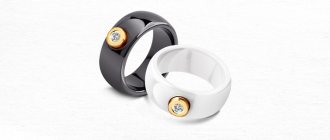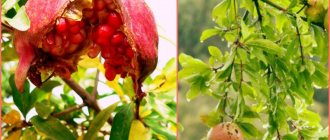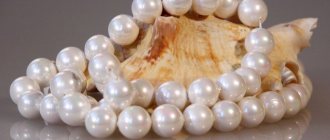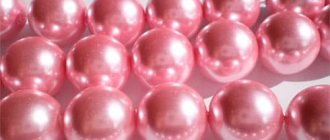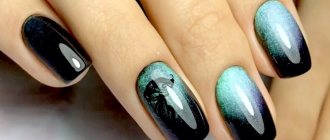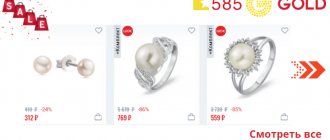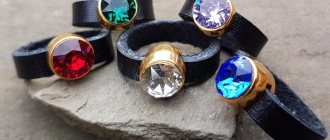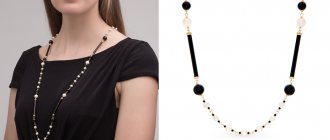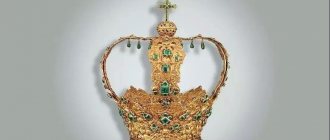Pearl colors
The popularity of a particular shade is not clearly visible; it all depends on the person’s preferences. The color is formed in the oyster, it all depends on the type and location. In the Persian Gulf, pink pearls are mined, which differ from others in their special shine. The golden hue can be found from the west of Australia.
Freshwater pearls differ in color intensity and are light silver in color or with a slight tint of yellow. It is mined not only in the natural environment, but also successfully grown artificially.
The cost of such pearls is less than that of a sea mollusk, because there can be up to 25 of them in a shell.
Physical and chemical properties
Pearls consist of nacre, which is an aggregate of the organic horny substance conchiolin and calcium carbonate (usually in the form of the mineral aragonite). The stone is not very hard and quite brittle. May be in different colors. Its brilliance and play of colors are explained by the wavy surface of mother-of-pearl. It is not a mineral, but is classified as a precious stone.
| Formula | Conchiolin and aragonite |
| Color | Various, often white, milky and silver, less often cream, pink, blue, gold, green, dark gray, light blue, black. |
| Shine | Pearl |
| Hardness | 3-4 |
| Transparency | Often opaque, less often slightly translucent |
| Strength | Fragile |
| Kink | Shellish |
| Cleavage | Absent |
| Density | 2.60-2.78 g/cm3 |
| Refractive index | For light varieties - 1.520-1.660, for dark and black varieties - 1.530-1.690 |
Pearl shape
The perfectly round type of pearl is the most expensive and is especially valued by jewelers. Checking the correct shape is very simple, just roll the ball on a flat surface. In nature, this form is not found very often, hence its inflated cost.
It is rare to find a pear or teardrop shape; the cost is estimated based on the presence of clear symmetry. In most cases, the shape is asymmetrical, but this does not mean that the cost of such pearls is lower. The fancier the shape and the more possibilities the designer has, the more expensive such decoration will be.
There are Baroque pearls on sale, which can be either freshwater or saltwater. Its shapes are very bizarre, but this does not in any way affect its popularity; on the contrary, the asymmetrical shape has found its application in jewelry.
Baroque pearls or baroque pearls
Baroque pearls
Gold bracelet with baroque pearls from Ray Griffiths
This is the general name for pearls that have an irregular original shape, regardless of their place of origin. Due to its unusualness and exclusivity, it is highly valued among many jewelry designers. Instead of the classic perfect ball, baroque pearls can resemble a drop, a disk, a cylinder, or a pear.
Especially notable are the so-called paragons - pearls that have the outlines of animals, human faces, bird wings, wolf fangs, etc. They have always been endowed with mystical properties and worn as talismans and amulets. In addition to their unusual shape, Baroque pearls are often distinguished by a ribbed pattern on the surface, similar to what sea waves leave on the sand.
Each pearl is unique and inimitable, so the demand and price for them remain at a consistently high level.
The shine of a pearl
It is the conchilion that affects the color of the pearl, and the quality of the shine will differ due to the number of nacre plates layered on top of each other.
The plates can be of different sizes and shapes, and as a result, light is reflected differently. The more shine, the more valuable the pearl. Quality is determined by professional jewelers who are familiar with the requirements for quality, shape, and size.
The size of the pearls varies. There is a very tiny one, which has also found its application in the jewelry industry, small up to 2.5 millimeters and medium up to 6 millimeters. The greatest rarity is to find a pearl larger than six millimeters; jewelry with such pearls is the most expensive.
Medicinal properties
Pearls are not deprived of healing power. He is capable of:
- Calm and have a general beneficial effect on the nervous system.
- Restore memory and improve concentration.
- Cure diseases and restore liver and kidney functions.
- Normalize blood pressure - raise it at low values, lower it at high values.
- Calm even severe headaches.
- Solve age-related and other skin problems - cleanse, nourish, rejuvenate, improve color, for which “pearl essence” (pearl powder) is used.
- Strengthen hair and nails.
- Improve a person’s overall well-being by relieving fatigue and feeding him energy.
Cultured pearls: what distinguishes them from fake and natural
Difficulties with obtaining pearls pushed the Japanese Kokichi Mikimoto to interesting and, most importantly, invaluable experiments for humanity. The scientist proposed not to look for mollusks with pearls inside, but to provoke them to work for humans under artificial conditions.
The essence of Mikimoto’s method was to “plant” a foreign body – a small ball – into the reproductive organs of the oyster, which she tried to neutralize using mother-of-pearl, just as she would have done under natural conditions. The result exceeded expectations. The Japanese have learned to obtain cultured pearls in this way. The price of the finished bead depended on the number of mother-of-pearl layers. On average, one of them took up to 8-10 months.
Improving technology, over time the Japanese decided to introduce foreign bodies not into the gonads of the mollusk, but into the mantle. This way we managed to speed up the process. One oyster simultaneously “carried” up to a dozen to one and a half beads!
Both sea and river pearls are cultivated using this technology. The latter can be of different colors. River cultured material can be:
- white;
- black;
- cream;
- green;
- silver;
- grey;
- eggplant, etc.
Both in photos and in life, it is almost impossible to distinguish natural pearls from cultured ones, especially when they are sufficiently seasoned.
From snuff boxes to guitars
A special type of mother-of-pearl inlay - in lacquer miniature - appeared in the 8th century in China, and then spread to Korea, Vietnam and Japan. The craftsmen selected shells of different shades to match the theme of the future miniature. The required pieces of mother-of-pearl were inserted into the recesses of the design and glued. The product was sanded by hand and then covered with several layers of varnish. To this day, there are entire villages in Vietnam and China that practice mother-of-pearl inlay.
The Oriental Museum provided for the exhibition several objects created in Vietnam at the end of the 19th and beginning of the 20th centuries. Among them are an album, vases, a table and a panel depicting the seasons.
Ivory, bidri and Vishnu avatar. Five Indian exhibits of the Museum of the East Morinhur and the mask of the mystery. Five exhibits from the Mongolian collection of the Museum of the EastDaruulga, Guu and White Tara. We study the Buryat collection of the Museum of the East Choydish, munisak and lyagan. Treasures of the Uzbek collection of the Oriental Museum
In Europe, mother-of-pearl began to be used in the 17th century; it was used to decorate fans, cases, snuff boxes, and caskets. Craftsmen often used whole mollusk shells. At the exhibition you can see, for example, a case for a pocket watch made from a single shell of a sea pearl oyster. It was made in France in the first half of the 19th century. The mother-of-pearl pearl oyster is framed in bronze, and the inside of the case is lined with velvet.
Sometimes craftsmen carved images of Christian saints on pearl mussels. Such icons became widespread in Palestine at the end of the 19th and beginning of the 20th centuries. They were brought to Russia by pilgrims who went to Palestine on pilgrimage.
One of the most interesting exhibits is a six-string guitar from the Ostankino estate museum. It was made in 1822 in St. Petersburg by the Polish master Frantisek Mackiewicz, who specialized in expensive guitars. The upper soundboard of the instrument and the resonator rosette are decorated with mother-of-pearl. You can also see a mother-of-pearl carved plate with the owner's monogram and a coat of arms with an image of an eagle.
Charms and talismans made of pearl stone
Pearl amulets will bring success in business.
Pearl amulets have the power to influence people. Such talismans were made in ancient Rome. They doubled the power and imparted wisdom to their owners.
Amulets made from the mineral are described in religious books. Special crowns symbolized connections with higher powers. Who is the pearl stone suitable for due to its properties? Amulets from it should be purchased by people who strive to improve relationships with others, as well as cope with pride and ambition. These talismans are a must have for businessmen and those whose professional activities are related to trade. They help to consider the prospects of concluded transactions and reduce losses.
Freshwater: differences from those mined at sea
An important difference between freshwater and marine mollusks is the ability to “bear” up to 30 implants at the same time. Gestation periods also vary. In the shell of a river organism, the process of creating a mother-of-pearl miracle requires less time.
In addition, in rivers and reservoirs there are no dangerous storms or changes in currents that can cause damage to grafted mollusks. All this affects the final cost of the material. To grow high-quality sea pearls, you need to spend more time, effort and money, and accordingly, the result is estimated to be tens of times more expensive.
It is impossible to grow river pearls perfectly smooth and round. It's all about the “nuclear-free” method used in the process of creating “peas”. A piece of the mantle of the donor organism, initially of an imperfect shape, is implanted into the shell of a mollusk.
The finished pearls are sorted, specimens with the most correct round shape are selected, and adjusted artificially. Round ones are used to make beads, bracelets, and rings.
Formations of irregular shape are not disposed of, but are transferred to the group of commercial material. Usually these are pearls of the form:
- potatoes;
- baroque;
- drops;
- buttons;
- rice, etc.
Some of them are used to create designer jewelry, additionally “adjusting” it to the desired shape. The rest are sent “for revision”, having previously been wrapped in a new layer of donor mantle. Pearls with faulty defects are crushed and used in medicine and cosmetology.
GROWING TECHNOLOGY
The name of the pearl bead depends on the water in which it grows: river (freshwater) or sea.
Wild pearls, like many centuries ago, are mined at the bottom of salt and fresh water bodies. Now this method is considered expensive.
To reduce costs, humanity decided to artificially cultivate the mineral, inspired by nature: therefore, the methods for producing river and sea pearls are almost the same.
The mystery of birth: in the sea and in the river
In the natural environment, a pearl is born by chance:
- The smallest foreign object gets into the sink: for example, a grain of sand.
- Protecting its internal space, the mollusk covers this object layer by layer with nacre.
- The more time passes, the more layers are formed and the more valuable the bead.
The hunt for such treasures is a long, expensive and very painstaking task. Therefore, a wild natural mineral is a rarity and an object of desire for investors.
Cultivated specimens are grown on special farms:
- Foreign particles are deliberately placed in a suitable sink.
- Further, the ritual of maturation is no different from the natural one.
- After about one and a half to two years, the beads are “ready for use.”
It is believed that the more time the pearl spent in the shell, the thicker and better quality its shell. Therefore, sometimes the mineral remains “in the house” for up to four to six years.
Nautical
Natural sea pearls are created by oysters that have chosen the salty waters of the oceans. The main deposits are located in Thailand, Australia, Indonesia, Tahiti and other countries.
One of the most popular is the “Akoya” variety. Grown in Japan, China and Vietnam. Recognized for its high quality, dazzling shine and almost perfect round shape.
We recommend: BAROQUE PEARL: casual in classic
River
As for freshwater pearls and what they look like, such minerals and their sea “colleagues” are practically twins. However, the creation of freshwater mother-of-pearl beads involves mussels that have chosen rivers and lakes. In one shell you can find up to 16 river pearls.
Nowadays, most river specimens are made in China, but previously freshwater pearls were collected almost all over the world.
Nuclear and non-nuclear technology: what is the difference
Cultured specimens are grown using two main technologies.
- Nuclear technology is considered optimal for obtaining the marine grade. A seed core is placed in the shell, which turns into a mineral.
- River (freshwater) pearls are grown using a nuclear-free method. This technology uses a mini-seed core: usually a piece of nacre from the shell itself. With a microscopic nucleus, a pearl needs more time to mature to the desired size than one growing using the nuclear method.
In terms of size, color and quality of nacre layers, cultured samples are in no way inferior to natural ones, and sometimes even surpass the original.
How to care for pearls
If you wear pearls with proper care, your jewelry will serve you for a very long time. They can even be passed on by inheritance, although esotericists do not welcome these actions. It is believed that the sea talisman absorbs the owner’s negativity and then passes it on to the next owner.
Care instructions:
- Jewelry should be stored separately from other jewelry. The mineral is very fragile, so try to protect it from falls and impacts with other talismans.
- The stone does not like heat and is afraid of high temperatures. Not only the sun, but also the artificial warm climate recreated indoors. So it’s better not to go to the bathhouse with him.
- By the way, cold and humidity can also harm the amulet. Being in such conditions results in a loss of shine for him.
- This is tricky stuff. It is not only fragile, but also does not like to interact with various substances. Perfume, foundation and hairspray can ruin it. Try to prevent jewelry from coming into contact with cosmetics.
To keep your jewelry beautiful, pearls need to be cleaned. Professionals use a weak solution of acetic acid for this. But if you are afraid to take the wrong proportions, you can replace it with a safer soap solution.
How are pearls formed in a shell?
Only stones coated with mother-of-pearl are of commercial interest. They appear in the following types of mollusks:
- Bivalve. This is the main “producer” of pearls. Of the freshwater species, unionids are distinguished - European and Kamchatka pearl mussels. In the depths of the sea these are mussels, scallops and many others.
- Gastropods. Haliotis and giant strombus are especially active.
- Cephalopods. Shells with pearls can only be found in one species - the common nautilus.
The giant tridacna mineral does not contain nacre. However, it is still valued for its beautiful pink or milky color.
Education process
Not all mollusks of the appropriate type have pearls in shells. For a mineral to appear, there must be a foreign particle in the body, for example, an insect, a grain of sand, or a piece of stone. There will be a “tear” here later. Back in the middle of the 20th century, zoologist Vladimir Zhadin found out that inside the mollusk there are several zones where pearls appear most often:
- the upper part of the fold of the body (mantle) or its thick section;
- muscle that closes the valves.
In its normal state, mother-of-pearl covers only the underside of the shell. If there is a foreign small object there, the body reacts to this:
- Nerve fibers are irritated.
- Epithelial tissue begins to rapidly divide. As a result, a special sac is formed - a cyst.
- The mantle is forced to secrete more mother-of-pearl. This is the building material for a new pearl.
Foreign objects in the body of a mollusk are not always necessary for the appearance of a natural mineral. Sometimes illness or injury is enough. The epithelium gets inside, and then the processes follow the same pattern.
The shape of the “tear” depends on the area in which the formation occurs. If the nacre is concentrated on the shell or muscles, the stone will turn out irregular. Often such pearls take on original shapes. When formed, there will be a pea-sized mineral in the mantle.
How long does a pearl grow?
The formation of pearls depends on several conditions:
- species, age of the mollusk;
- water composition;
- state of ecology.
The most active growth occurs in the first year: about 2-3 mm. Then the speed slows down - no more than 0.5 mm. The size of the pearls in the shell also depends on age. The younger the mollusk, the larger its decoration. Over the years, the pearl oyster's mantle weakens, so the stone becomes smaller.
Natural jewelry grows in nature for an average of about seven years. On farms this time is seriously reduced to 2-3 years.
River clams produce more stones. But sea pearls are approximately twice as large. This is due to the conditions for growth: chemical composition and water temperature. The longer the bead is created, the thicker the layer of mother-of-pearl on the surface and the more valuable the specimen.
The magical properties of pearl stone
It is better for greedy and self-centered people to avoid pearls.
Even in ancient times, this mineral was considered an excellent amulet, protection against aging and a means to prolong youth. There are legends that Cleopatra herself drank pomegranate juice infused with pearls every day. In addition, she always wore jewelry made from this stone. The unfading beauty and youth of the great ruler are associated with such a ritual and love for the mineral.
The main thing is that pearl products are not passed on by inheritance, as this can cause many misfortunes. This is especially true in cases where the previous owner had an unenviable fate and numerous difficulties. It is believed that all pearls not only attract, but also retain the negative energy of their owner for a long period of time.
Pearls should not be bought by people who have no willpower and whose spiritual condition is shaky. Its owners should always engage in self-improvement and development.
The mineral is not suitable for a greedy, malicious and envious person who is incredibly proud and narcissistic. In different countries, pearls are a specific symbol and have been endowed with special qualities.
In India, the magical properties of the pearl stone are attributed to caring for the well-being, financial stability and prosperity of its owners. In European countries, it becomes a guarantor of longevity, eternal youth, incorruptibility and ideality. In China, the stone is responsible for fertility, humanity and support of magical abilities. In Greece, among the magical properties of the pearl stone, strengthening the marriage union stands out.
In many countries, people are confident that pearls give long life and also protect against inflammation and disease. You can admire them for hours. In this case, there is no direct need for special rituals. Regular viewing leads to calm and relaxation. The stone pacifies and balances the senses.
Other magical properties of the pearl stone include:
- getting rid of love torments;
- protection of the home from thieves and ill-wishers;
- protection from negativity and bad thoughts;
- assistance in getting rid of unscrupulous partners and dubious transactions;
- a philosophical attitude to what is happening and alignment of mood.
